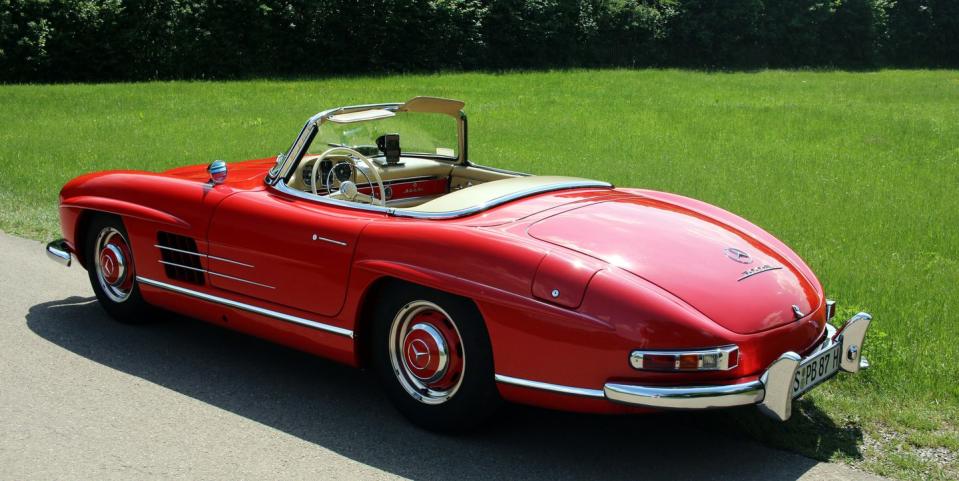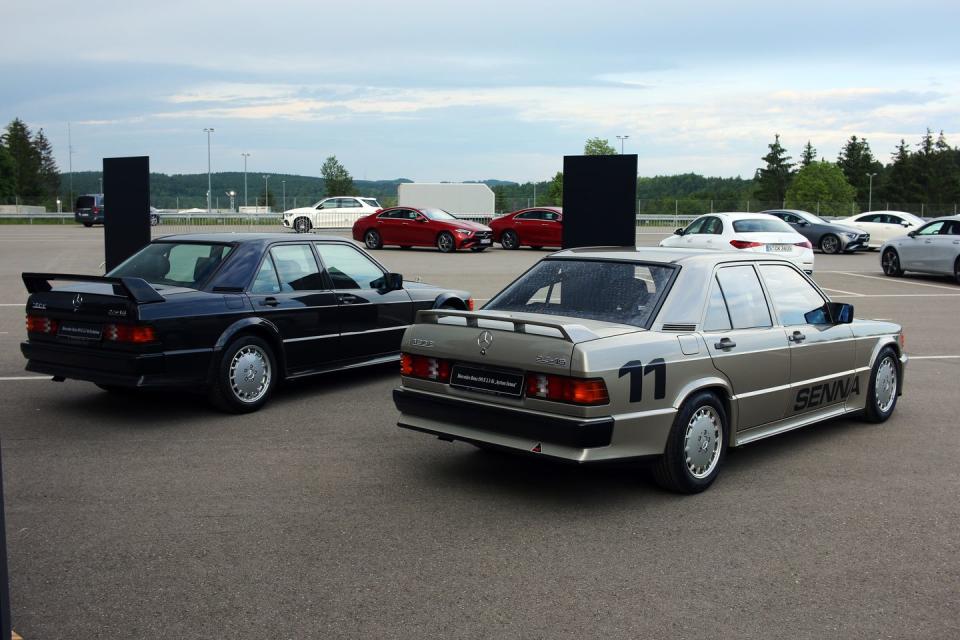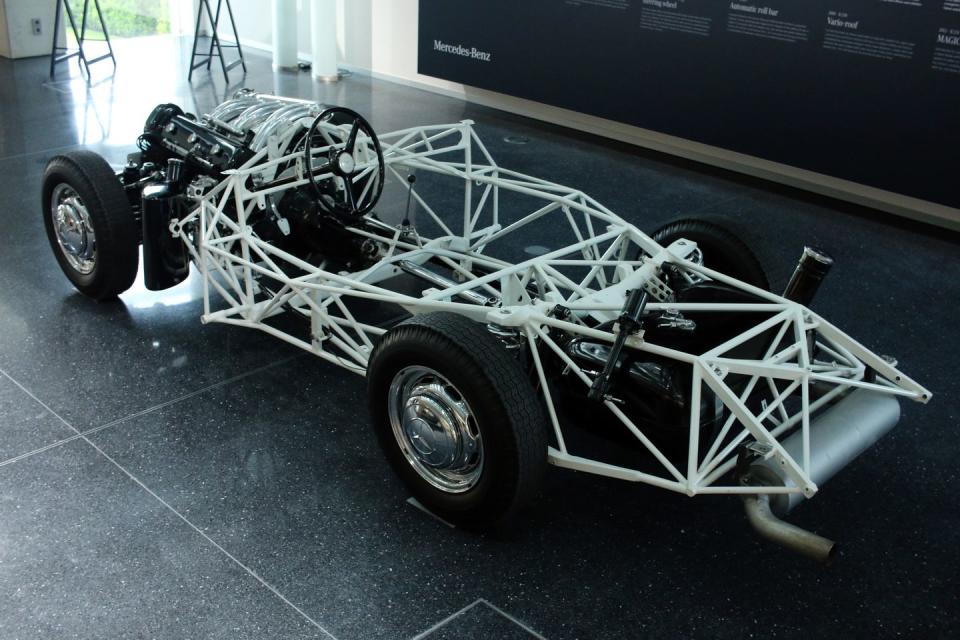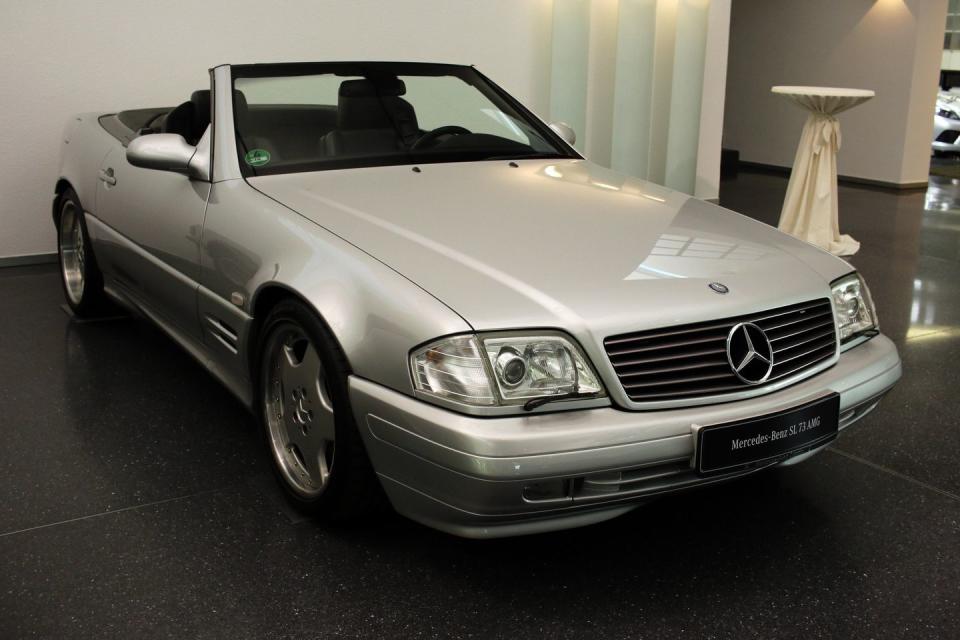Driving Six Legends From the Mercedes-Benz Museum

When Mercedes-Benz invited me and several other journalists to drive the 2022 C-Class for hundreds of miles through picturesque Germany, it came with a few excellent perks. Namely, the opportunity to slide behind the wheel of a few relevant members of the Mercedes-Benz Classic Museum's collection of around 1200 carefully maintained vehicles. The only sensible choice was to skip lunch, and most bathroom breaks, to try out as many machines as time would allow. On the menu: past generations of the C-Class as well as the SL, the roadster that returns to a 2+2 layout once again in 2022.
There was also Ayrton Senna's smoke silver 1984 190E 2.3-16, with which he won the Nürburgring Race of Champions. It currently has 1333 miles on its clock. Understandably, it wasn't my turn to change that.

In 1984, the 24-year-old and mostly unknown Toleman F1 driver Ayrton Senna pushed this 190E 2.3-16 to victory at a greasy Nürburgring, beating Niki Lauda and Carlos Reutemann in the process. The grid was made of 20 identical 16-valve W201 sedans, kicking out 183 horsepower from a Cosworth-tweaked engine with multiple Nardo endurance records under its belt. Showing the most subtle rear spoiler of all fast 190s, the Race of Champions cars were mostly stock, sitting 15mm closer to the ground on stiffer springs and shocks, rolling on slightly wider rims wearing Pirelli P7 tires, and sounding mean through a straight exhaust. Fixed four-piston brake calipers up front and a 4.08 final-drive round out the modifications. Legend has it that the steering wheel's diameter was reduced by 20mm, to 380, though I left my tape measure at home. Senna's No. 11 now belongs to the Mercedes-Benz Museum.

After poking around the car that made a number of seasoned F1 drivers remember Senna's name, it was a bummer to learn that the charcoal 190 E 2.5-16 Evolution I parked next to it was also off-limits for road driving. However, thanks to a kind Museum employee taking all responsibility, I was able to take a very short, very slow jaunt behind the Evo I's wheel, making the most of its dog-leg gearbox and short-stroke engine around the pits and almost getting the homologation-special engine up to operating temperature. Even after such a limited drive, it was clear that the 2.5-16 is a classic worth hunting down, regardless of what your friends have to say about the similarly sought-after E30 M3 Sport Evolution. With its Cosworth head, the 190E 2.5-16 Evo I is not only a better built machine, it’s also a more outrageous design, and a sports sedan encouraging longer road trips. That’s the kind of versatility and cheekiness I’d want from a late-Eighties icon with a big trunk.
By 1992, the W201 had been in production for a decade, and had just one year to go before it would be replaced by the first C-Class. It was time for a send-off special edition, this one designed by the women of the art department.
Limited to 4600 units in total, the Avantgarde trio consisted of three daring color combos: Red metallic Rosso with a modern-art-inspired interior; metallic green Verde with green-and-black polka-dot "Anton" fabric interior; and the blue metallic Azzurro you see here, complete with a black leather interior featuring multi-colored piping for fun. Described in 1992 as "the powerhouse" member of the series, the Azzurro came with the Sportline suspension that dropped ride height by almost an inch, plus wider wheels and tires, carbon fiber trim pieces, and power and heated everything. This member of the Mercedes collection is the final Swiss-market Azzurro, number 120/120.
On well-preserved 190s, the doors shut with a satisfying click. Even just a short time with one makes you realize this is just about the perfect compact sedan, both in terms of size and visibility. Yet despite the funky seats and carbon-fiber trim, this example offered only modest thrills with its ancient 4G-Tronic automatic rather than a five-speed manual. Still, it's a relatively lightweight machine that feels nice in the corners, and with 134 hp, this car was claimed to be capable of 124 mph, thanks in part to no catalytic converter. It is by no means a quick car. Instead, it’s a cocktail of an elegant paint job, a quintessentially Nineties cabin, a subtle stance, and every convenience feature you could get in a bigger Benz sedan at the time. And three decades later, it's a nice classic.

Work on the W202 series, the first generation of the C-Class, began in the fourth year of W201 production. By May of 1993, the new car was ready to take on the role of entry-level Benz, years before the brand's first subcompact, the A-Class, came along. Designed by Olivier Boulay and Murat Günak, the W202 spawned a number of AMG variants and brought Roots-type superchargers back to Mercedes. Thanks to Daimler selling more than 1.6 million W202s in total, the common six-cylinder version is hardly considered a collector's item today.
As the most powerful non-AMG C-Class, the C 280 was first available with the 2.8-liter 24-valve M104 DOHC straight-six, then with the 2.8-liter 18-valve SOHC M112 V-6 from 1997. In 1996, you could pair Mercedes-Benz’s new five-speed automatic with the 190-horsepower inline engine, and if you felt really outrageous, you could even opt for the Designo green metallic exterior, coupled with the weird marble-like trim and "tone-in-tone" black and green leather interior.
Stepping into the C-Class after driving a supposedly peppy 190 E takes you into another era of Mercedes-Benz, a time when German luxury cars became larger and more complex. The W202 feels substantial, as well as more powerful, with its DOHC straight-six. Yet the biggest improvement over its predecessor might just be the 5G-Tronic automatic. More eager in Sport mode (thanks to all the torque) and happy to kick the engine to well above 6000 RPM to unleash the power, the Museum’s fully-loaded 1996 C 280 remains a loud and proud luxury missile when your right foot demands it, even without an AMG badge.

Chances are, if you’re thinking of the Mercedes SL-Class, you're envisioning the ultimate 2+2 roadster of the Seventies and Eighties. It's the Dallas car, codenamed R107, and most often witnessed with a V-8 up front. As pleasant as a 500 SL may be, Mercedes-Benz built its reputation on inline-six engines, and since I tend to lean towards lighter stick-shift cars anyway, my preference sits with this 300 SL. The third-generation SL had the second-longest production run of any Mercedes, at 18 years, surpassed only by the original G Wagen. For 1985, the refreshed SL line got bigger engines with upgraded fuel injection systems, larger brakes, and even wider tracks. All that turned the former 280 SL into the 3.0-liter 300 SL, good for 187 horsepower and 188 lb-ft of cruising potential.
Behind the wheel, the classic proportions of the SL send a clear message to your brain: It's time to relax. The hood stretches out enormous in front of you; the cabin stretches out in all directions. This is a rolling lake house with four leather seats. The main occupant of the cabin is the huge impact-absorbing steering wheel, first introduced by Mercedes-Benz in August 1967. Dominating the driving experience, this yacht-size device only passes suggestions to the front axle. The 300 SL is all about uncompromising luxury. At around 3400 pounds, with the smooth inline-six producing just under 190 hp and a roughly equal amount of torque, this example from the SL's most successful generations is by no means fast, and the rather inaccurate five-speed manual can only add so much interaction to the otherwise effortless journey.
But forget about speed. It looks utterly perfect in Signal red, doesn’t it?

As elegant as the R107 is, its predecessor takes the cake. Penned by Paul Bracq, engineered by Béla Barényi and nicknamed Pagoda after its unmistakable hardtop, Mercedes-Benz built just under 50,000 of this impressively safety-conscious roadster between 1963 and 1971. Representing a huge shift from the previous SL, a racing prototype turned into a California dream dar, the W113 roadster is a jewel, sporting a pioneering design and the sort of world-beating build quality Benz fans will cherish forever. This top-of-the-line 280 SL is powered by a 2.8-liter inline-six producing 170 hp, and it’s worth its weight in hard currency on looks alone.
The 280 SL is full of surprises. Its straight-six might be smooth as butter, but the four-speed automatic is amazingly responsive, using a fluid coupling instead of a conventional torque converter, and begging to be manually shifted between second and third on a winding road, accompanied by pops and bangs from the twin exhausts. Reassuring power, throaty sound, a lightweight chassis and a soft yet fairly quick steering system combine with real wood on the dash and a classy, chrome-accented instrument cluster to make a sporty, stylish roadster. It's pretty much impossible not to fall in love with the stunning Pagoda, especially when its namesake hardtop is nowhere to be seen.

Mercedes also brought the originator of the SL line, the tube-framed engineering marvel that started it all. This fire-engine red example has a current market value of $1.1 million, and I wasn't even supposed to drive it. Mercedes-Benz keeps roughly 20 prime-condition 300 SLs at headquarters (both Gullwing coupes and roadsters), and while the automaker brought a silver example to celebrate the announcement of the new SL-Class, that car was occupied by a mysteriously long video shoot.
So the Museum team was kind enough to introduce me to Manfred, a longtime master mechanic and, it turns out, a devoted fan of pre-war NSU motorcycles. With this Mercedes-Benz Museum guru in the passenger seat, I was given the blessing to drive off in the red SL.
There are benefits to having a passenger who knows this car inside and out. For example, when this otherwise flawless roadster began running on five cylinders, Manfred assured me the only cure was to treat this Fifties racing engine as it was meant to be driven, flooring it until proper combustion returned.
At that moment, the immense value of this iconic machine is irrelevant. People take notice of a fire-engine red 1958 300 SL in their midst, especially on the outskirts of Stuttgart, and they take extra precaution to give this machine the respect and space it deserves. The 300 SL was more than capable of keeping up with modern traffic. Back when it cost $11,000 new, this car was outrageously ahead of its time. Comparing it to anything from the mid-Fifties feels unfair.
Once warmed up, this car has a dual personality. There are no side mirrors, no seatbelts, just a skinny steering wheel, a tight four-speed gearbox that’s a joy to use, a dashboard shiny enough for Hollywood, and a chassis that seats you low in the name of racing. The car is dripping with that delightful feeling that only smart engineering can convey.
Built like a tank and propelled by a fittingly powerful 3.0-liter six, the 300 SL Roadster gives you loads of torque below 4000 RPM for comfortable all-day driving. But the casual cruiser disappears as soon as you rev the engine—the dry-sum straight-six makes its peak output at 6100 RPM, and to put it mildly, between 4000 and 6000, it becomes a monster. It hungers for a full attack on the Mille Miglia.

Starting in 1957, Mercedes-Benz built 1858 examples of the 300 SL Roadster. Each came with a 240-hp engine, an upgraded suspension, and a revised chassis that both improved handling and offered a more conventional door opening, no more shimmying over the sill. With the engine screaming at six grand, encouraged by a hearty thumbs-up from Manfred in the passenger seat, I certainly didn't miss the signature doors and tight-cropped roof of the Gullwing coupe.

Daimler keeps no public records as to how many V-12-powered SL roadsters were converted to 7.3-liter power between 1999 and 2001. Educated guesses put the number somewhere around 85 units. What's certain is this: The car that resulted, the SL 73 AMG, is a legend. The DOHC M297 V-12, known from the Mercedes-Benz CLK GTR Straßen Version (as well as every Pagani Zonda), is a sight to behold when shoehorned into the nose of a W129 SL. This will always be the largest modern car engine Mercedes has ever produced, sold without a warranty.
The next generation Mercedes SL will be an all-aluminum machine when it arrives in 2022. It'll return to the classic 2+2 layout, and it will be built by AMG right from the start. A return to the dynamic form of high-performance SLs of days past? We certainly hope so.
You Might Also Like

 Yahoo Autos
Yahoo Autos 